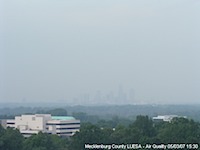This activity introduces you to Project Ozone. You will be asked to identify what you know and questions you have about ozone. You will also learn to differentiate between ground-level ozone (the bad ozone), and ozone in the upper atmosphere (the good ozone).
- Identify and discuss prior knowledge of ozone
- Generate questions about ozone
- Explain what is the difference between ground-level and ozone in the upper atmosphere.
Web articles as well as newspaper and science magazine articles, and sections from science texts about ozone, chart of the atmosphere.
Advance Preparation
Well in advance of doing this project, you should visit anyone of the following websites:
AIRSdata Site---The Air Pollution Monitoring Site
Everything you wanted to know about air pollution: An EPA Site
Office of Air and Radiation at EPA.
The Other Ozone---sometimes called the Good Ozone
Procedures
1. Webcams and Air Pollution. Use the Air Quality Webcam link in the menu to visually compare air quality in different locations. The webcams refresh usually about every 30 seconds and show you a live picture. How does the air in the scene you look at compare to the scence when you look out a window in the room you are in right now. Here are some links directly to city Webcams:
2. You should divide yourselves into teams of four, and obtain a large sheet of paper, and colored pens or crayons. You and your teammates should draw a picture showing the earth and two of the layers in the atmosphere, as well a satellite in space, and the sun in the background. Then consider the following :
In the next ten minutes you and your teammates should work as a team, and discuss what you know about ozone. Use the picture to draw and explain what your team knows. In your drawing and explanations, please try to use the following ideas as well as others that you know: ozone, smog, car emissions, ultraviolet light, people, plants.
When your team is finished be prepared to:
- Report your ideas to the class
- Write a brief summary of your ideas and post it on the classroom bulletin board. Make sure you post it under the heading, "Initial Theories & Ideas About Ozone."
When you have finished hearing the reports, a member from your team should mount the picture on a wall in the classroom. Keep these pictures visible throughout the project, and refer to them when it seems appropriate.
2. Have you ever heard of terms, "good ozone" or "bad ozone?"
- Your group of four should make a T-Chart summarizing the differences between "good" and "bad" ozone. Post the T-Charts in a prominent place in the classroom
Characteristics of "Good" Ozone |
Characteristics of "Bad Ozone |
List characteristics of "good" ozone |
List characteristics of "bad" ozone
|
3. Summarize your work by discussing the following concepts. Use the links to extend your understanding.
- Tropospheric (the lower atmosphere) ozone is produced when the gases given off from burning fossil fuels combine with sunlight.The result is ozone or smog.
- More data is needed about the sources, patterns and effects of tropospheric ozone.
- Lower atmospheric ozone is found in high concentration in many of the urban centers of the earth.
- Stratospheric (the upper atmosphere) ozone is formed when ultraviolet radiation brings about the breakup of O2.The free oxygen then combines with another molecule of oxygen to form O3.
- Over a long time, the concentration of ozone has increased in the stratosphere enough so that a protective shield has been created that screens out almost all of the ultraviolet radiation reaching the earth.
- Presently there is a concern that certain chemicals (chlorofluorocarbons--CFCs) released into the atmosphere in recent years are reactive in the stratosphere by breaking down in the presence of ultraviolet radiation. The free chlorine atoms that are released attack ozone molecules breaking them into oxygen and chlorine oxide. This process is responsible for the depletion of the ozone layer, and has resulted in the presence of a hole in the ozone layer over the Antarctic during Spring.
- The depletion of the ozone layer could result an increase of ultraviolet radiation reaching the earth's surface, which would cause damage in nearly all forms of life.
1. Have your students keep a "scientific log or journal" of their work on Project Ozone.Students can collect articles about ozone, newspaper clippings, as well as keep track of their work on the Project.
2. Students might want to produce a "newsletter" on ozone. Newsletters typically are very short---perhaps two pages, and summarize interesting ideas about a particular topic. Some of the students might want to create an Ozone Newsletter that could be shared with other students in the school, as well as over the network.
3. You and your students may want to create an air pollution or SmogWatch website and make it known to other schools.

